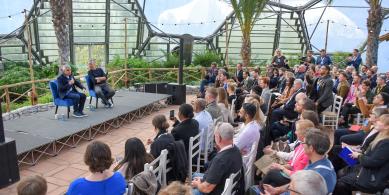Study the current US election for a week or two and you’ll notice one word turn up again and again in the commentary: narrative. Politicians control the narrative, they reinforce the narrative, they seize the narrative, they reshape the narrative, they build the narrative, and that’s before the voters get their say, at which point they might defy the narrative, overturn the narrative, confirm the narrative, or perhaps just get heartily sick of the narrative and stay home. They might have the sympathy of Washington Post writer Erik Wemple, who last month wrote a heartfelt column: “A Plea To Pundits: Stop Saying ‘Narrative’”
Narrative is one of those words that starts off sounding smart and ends up sounding clichéd. Marketing has those kind of words too – “engagement”, or “insight”, or “disruption”. Such words gradually begin to lose much of their specific meaning. But that doesn’t mean they never had any. All these overused words have kernels of something useful inside them. In the case of narrative, what the word intuits is a truth the psychologist Jonathan Haidt has succinctly expressed. Human beings are not logic processors. We are story processors.
What Haidt means is that we understand the world through story. We make judgements about what is happening based on what we suspect is going to happen, but the frameworks we fit that information into are story frameworks. Narratives, in other words. Political campaigns are powerful engines of narrative, and in the 2016 Presidential campaign we see plenty of storytelling at work. Donald Trump is promising Rebirth – an emboldened and empowered America confronting its enemies again. Ted Cruz is trying to finish the story begun by the Tea Party, a Rags-to-Riches story of insurgent grassroots conservatism gaining power. Bernie Sanders has an Overcoming the Monster narrative, taking on the overweening influence of Wall Street and big money in politics. And in the last few weeks Hillary Clinton has embraced the traditional progressive Quest narrative, talking – in a pointed jab at Trump -about breaking down barriers not raising new ones.
Not all these stories can come true. And from my position sitting in the UK, it’s fascinating – and a little frightening – to see them fight it out. But do stories really matter that much – in politics, and indeed in commercial research?
I think they do. This week I’ve been reading Sam Delaney’s Mad Men & Bad Men: When British Politics Met Advertising. It’s about the various political advertising campaigns of the last thirty years of British politics, from the historic 1979 election, when Conservative leader Margaret Thatcher ousted the incumbent Labour government with the help of the then little-known Saatchi & Saatchi. The ad agency’s weapon, created by copywriter Andrew Rutherford, was a poster campaign based on a cruel pun: a long queue of people outside an unemployment office, with the slogan “Labour Isn’t Working”.
Delaney’s book is a rollicking, scandalous read: it starts with ad men sprinkling powdered amphetamines over some prime ministerial canapes, and doesn’t really let up. But a pattern soon emerges. Delaney asks the advertising executives, did the ads make a difference? Certainly, they reply. Then he asks the same question of the politicians. Certainly not, they say.
Who’s right – the advertisers or the politicians? The evidence suggests that advertising doesn’t shift the results of elections much, at least in Britain. It can’t persuade people to change their vote. But maybe it isn’t trying to. In that 1979 election, the Labour poster campaign is now almost forgotten – it was themed around a single candle (representing the power cuts which crippled early 70s Britain) and asking voters to remember what happened the last time they let the Conservatives into power. Both campaigns were entirely negative. Both were dominated by a simple, memorable image. Both were starkly emotional appeals. With hindsight the Conservative one has survived as an example of great communication, but in Delaney’s book the ad executives around at the time say that Labour’s posters were just as good – maybe better! So what difference could advertising have made?
The answer lies in that maligned word, the narrative. The political posters weren’t making an argument. They were trying to capture – as succinctly as possible – a story. The Labour poster was conjuring up the bogeyman of what had happened in the past. The Conservative one was summing up what was happening then and there. Political advertising wasn’t about persuasion, it was about reinforcement, by summing up – in as simple, intuitive, and emotional a way as possible – the story each party was telling.
And the successful party was the one whose story most people recognised and believed. So what does that tell us about the US election? It says, quite simply, that “the narrative” really does matter. Candidates need to find a story about themselves and the country that feels credible, that they have permission to tell, and that voters want to come true. The one who can do that, and who uses the media effectively to put that story across, will win.
Why are stories so powerful? It’s all down to how people make decisions. As is now broadly accepted, human beings are not in general slow, considered decision-makers who carefully weigh up options. Instead, they choose quickly, using decision-making shortcuts, or heuristics. The most important of these heuristics are the availability heuristic (does this choice come readily to mind?), the affect heuristic (does this choice feel right?) and the processing fluency heuristic (do I recognise this choice quickly?).
Or to put it more simply – Fame, Feeling and Fluency. If the brand comes easily to mind (Fame), feels good (Feeling), and is quickly recognised (Fluency), it will be a popular choice – no matter what its more ‘rational’ or ‘differentiating’ properties are.
Having a good story is so powerful for a brand or a politician because it helps you build up all three shortcuts. A memorable and simple story helps build Fame and get the brand known. A story which resonates with what people feel is true will help create positive Feeling. And well-executed stories will help create characters and slogans which serve as unique assets for a brand and build recognition and Fluency. The cliché is right – it is the way you tell ‘em.
Which means one of the things researchers might do is spend a bit more time taking the “narratives” themselves as their topic of study. At BrainJuicer we’ve developed a tool called Storyteller, which takes the seven basic plots you find in stories all over the world (like Rebirth, Overcoming The Monster, and Quest – the full seven can be found in Christopher Booker’s The Seven Basic Plots book). It then applies them to brands, politicians, or almost any other topic. We ask which of the stories are credible when told about a brand, and how people would feel if they came true. The result is a guide to the stories that matter – the ones people have permission to tell, which might catch emotional fire and help win commercial (or electoral, for that matter) advantage.
For instance, we used Storyteller to understand the narratives behind supermarket giant Tesco in the UK and ride-sharing market leader Uber in the US. In both cases what we found was a current story – the narrative people most believe – which differed from the brand’s ideal story, the one people would feel happiest about.
In Tesco’s case, the brand remains the UK’s number one despite several years of weak sales and several scandals. The narrative people associated with it was Comedy – in which the bumbling, hapless hero is alright in the end despite his or her many mistakes. Comedy isn’t a great storyline for a brand! It tends to be associated with companies who are “too big to fail”, and people assume will always survive whatever mess they land in.
But Tesco had another option – not quite as credible but far more emotionally satisfying: Rebirth. Rebirth is a story of brands learning from where they went wrong and getting back on the road to greatness. The results showed that this was what UK consumers wanted to happen with Tesco. Tesco had permission to tell the Rebirth story.
As for Uber, it’s often presented as an Overcoming the Monster storyline – taking on the big taxi firms. But people didn’t actually believe or like that idea much: it was just too aggressive. Instead they saw Uber as a Journey and Return story, a brand that draws on outside expertise (in this case, its digital know-how) to create innovation.
Our analysis showed that people believed this story, and it made them quite happy – but to really improve Feeling, Uber ought to aim for Quest: making transportation better for everyone, not just cheaper. By looking at people’s reasons for believing and disbelieving the stories, we found that safety was the main barrier preventing Uber telling its ideal story.
These examples show how understanding the stories people fit brands into can help marketers understand consumers and set long term strategy. Telling the right story is one of the best ways of boosting Fame, Feeling and Fluency and making a brand quick and easy to choose.
It’s also one of the best ways of getting people to vote for you. But brands should remember the lessons of politics. Using narrative well is not about persuading people of the story you want to tell. It’s about finding the story they already believe – or are close to believing – that works best for you. Find the story you have permission to tell, and everything else gets a whole lot easier.
Read more from Tom Ewing and Brainjuicer in our Clubhouse.
Newsletter
Enjoy this? Get more.
Our monthly newsletter, The Edit, curates the very best of our latest content including articles, podcasts, video.
Become a member
Not a member yet?
Now it's time for you and your team to get involved. Get access to world-class events, exclusive publications, professional development, partner discounts and the chance to grow your network.




